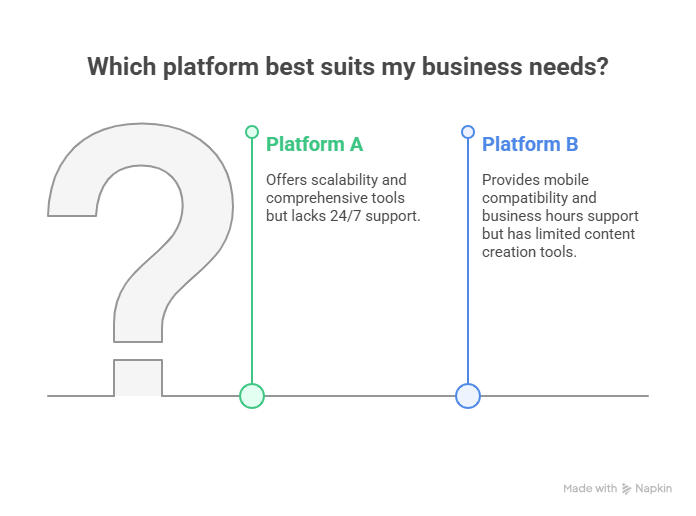The e-learning market is booming, with the global e-learning industry projected to reach $240 billion by 2028. As educational institutions and corporations increasingly adopt online learning solutions, the demand for effective e-learning tools has never been higher.
With so many options available, selecting the right e-learning platform can be a daunting task. To make an informed decision, it’s essential to consider several key factors, including the platform’s features, scalability, and user experience.
By understanding what to look for in an e-learning platform, you can ensure that your chosen solution meets your needs and provides a solid foundation for your online learning initiatives. In this article, we’ll explore the top tips for choosing the best e-learning platform for your organization.
Why Choosing the Right E-learning Platform Matters
The importance of choosing the right e-learning platform cannot be overstated, as it directly influences the quality of online learning experiences. With numerous options available, comparing and evaluating these platforms is crucial.
Effective online learning relies heavily on the platform’s ability to provide a seamless, engaging experience. This is where a thorough online learning platform comparison comes into play, helping educators and learners alike make informed decisions.
The Impact of E-learning on Modern Education and Training
E-learning has revolutionized the way we approach education and training, offering flexibility and accessibility. The right e-learning platform can enhance this experience, making it more interactive and effective. When evaluating top e-learning solutions, it’s essential to consider their impact on modern education.
| Feature | Basic Platform | Advanced Platform |
|---|---|---|
| Interactivity | Limited | High |
| User Support | Basic | Comprehensive |
| Customization | Limited | Flexible |
Common Challenges in Platform Selection
Despite the benefits, selecting the right e-learning platform can be challenging. Common issues include assessing the platform’s technical capabilities and ensuring it meets specific learning needs. Understanding how to choose an online learning platform that aligns with your goals is vital.
By carefully evaluating these aspects and considering the unique needs of your educational or training program, you can make an informed decision that enhances the learning experience.
10 Essential Tips for Choosing E-learning Platforms
Selecting the right e-learning platform is a crucial decision that can significantly impact the effectiveness of your training programs. With the rise of online learning, the demand for high-quality e-learning platforms has increased, offering a wide range of options for businesses and educational institutions.
Define Your Learning Objectives
Before diving into the vast array of e-learning platforms, it’s essential to clearly define your learning objectives. Understanding what you aim to achieve through your e-learning initiative will help you narrow down your options.
Tip1: Identify Your Target Audience Needs
Understanding your target audience’s needs is crucial. Consider their learning preferences, technological proficiency, and the devices they use.
Tip2: Establish Clear Learning Goals
Establishing clear, measurable learning goals will guide your choice of platform and content. Ensure these goals align with your overall training objectives.
Evaluate Technical Features
The technical features of an e-learning platform can significantly affect user experience and the overall success of your training program. Here are key technical aspects to evaluate:
Tip3: Assess Content Creation Tools
Assess the platform’s content creation tools. Look for features like templates, multimedia support, and the ability to import content from various sources.
Tip4: Examine User Interface and Experience
The user interface should be intuitive and user-friendly. Consider the layout, navigation, and overall user experience on both desktop and mobile devices.
Tip5: Verify Mobile Compatibility
With the increasing use of mobile devices, ensure the platform is fully compatible and offers a seamless experience across different screen sizes.
Consider Support and Integration
A good e-learning platform should offer robust support and integration capabilities to ensure it meets your current and future needs.
Tip6: Review Available Customer Support
Look for platforms that offer comprehensive customer support, including live chat, email, and phone support, as well as extensive online resources.
Tip7: Check Integration Capabilities
Ensure the platform can integrate with your existing systems, such as HR software, CRM, and other tools.
Tip8: Evaluate Scalability Options
Consider whether the platform can scale with your growing needs, offering flexible plans and the ability to add more users or features as required.

| Feature | Platform A | Platform B |
|---|---|---|
| Content Creation Tools | Yes | Limited |
| Mobile Compatibility | Yes | Yes |
| Customer Support | 24/7 | Business Hours |
Analyze Cost and Value
Finally, it’s crucial to analyze the cost of the e-learning platform and the value it provides. Consider both the direct and indirect costs, as well as the potential return on investment.
Tip9: Compare Pricing Models
Compare the pricing models of different platforms, considering factors like subscription fees, per-user costs, and any additional charges for features or support.
Tip10: Calculate Potential ROI
Calculate the potential return on investment by considering factors like increased productivity, reduced training costs, and improved learner outcomes.
Take Advantage of Free Trials
Many e-learning platforms offer free trials or demos. Take advantage of these to test the platform’s features and usability before making a final decision.
By following these 10 essential tips, you can make an informed decision when choosing an e-learning platform that meets your needs and maximizes your training investment.
Conclusion: Making Your Final Decision
Selecting the right e-learning platform is a crucial step in achieving your learning objectives. By following the tips outlined in this article, you can make an informed decision that meets your needs. When comparing online learning platforms, consider factors such as technical features, support, and integration, as well as cost and value.
Carefully evaluating these aspects will help you choose a platform that enhances your learning experience. By doing so, you’ll be able to find the best fit for your educational or training needs, ultimately leading to a more effective and engaging learning experience.
Use the tips for choosing e-learning platforms to guide your decision-making process, and don’t hesitate to explore different options through online learning platform comparison to find the one that best suits your goals.
FAQ
What are the key factors to consider when selecting an e-learning platform?
When choosing an e-learning platform, consider factors such as learning objectives, technical features, support and integration, cost, and scalability to ensure the platform meets your needs.
How do I evaluate the technical features of an e-learning platform?
To evaluate technical features, assess content creation tools, user interface and experience, mobile compatibility, and integration capabilities to ensure the platform is user-friendly and functional.
What is the importance of customer support in an e-learning platform?
Customer support is crucial as it provides assistance and resolves issues promptly, ensuring minimal disruption to the learning process and helping to maximize the platform’s potential.
How can I compare the pricing models of different e-learning platforms?
Compare pricing models by considering factors such as cost per user, subscription fees, and any additional charges for features or support to determine the best value for your investment.
What is the benefit of taking advantage of free trials for e-learning platforms?
Free trials allow you to test the platform’s features, assess its usability, and determine whether it meets your needs before committing to a purchase, reducing the risk of a costly mistake.
How do I assess the scalability of an e-learning platform?
Assess scalability by evaluating the platform’s ability to grow with your organization, accommodate increasing numbers of users, and adapt to changing learning needs.
What are the advantages of using an e-learning platform with mobile compatibility?
Mobile compatibility allows learners to access courses and materials on-the-go, enhancing flexibility and convenience, and improving the overall learning experience.
How can I ensure that the e-learning platform integrates with my existing systems?
Check the platform’s integration capabilities, such as APIs, LMS integrations, or compatibility with other software, to ensure seamless integration with your existing infrastructure.

